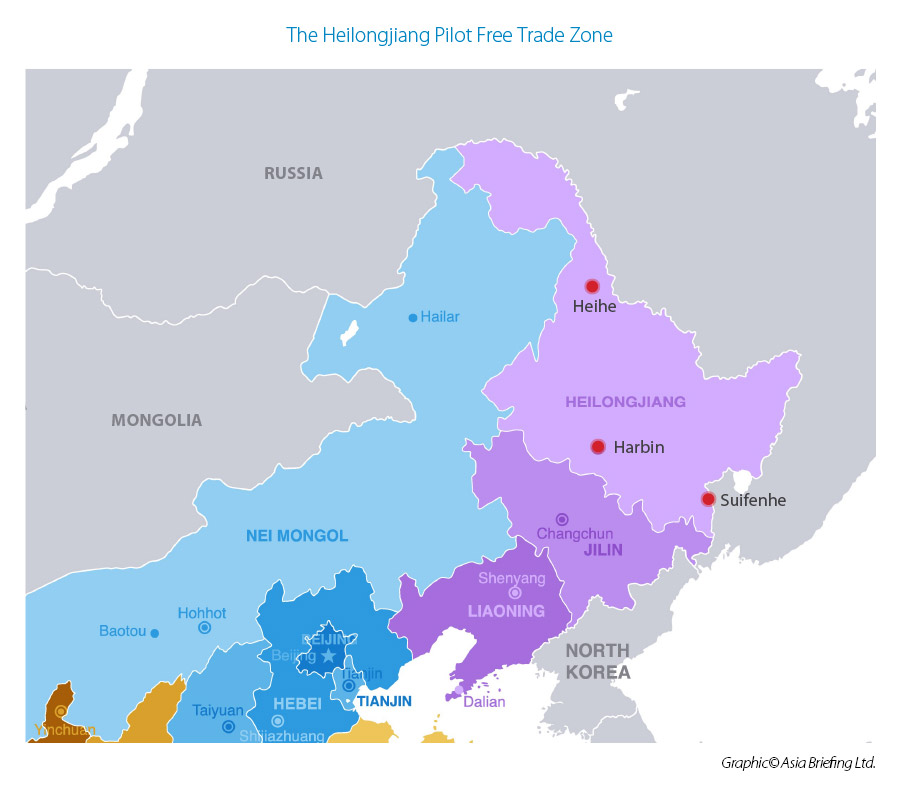Heilongjiang Pilot Free Trade Zone Booms as China-Russia Trade Shows Sharp Increase

Access to seaports and Trans-Siberian rail help the Heilongjiang FTZ attract nearly 9,000 corporate investors.
China’s northernmost Free Trade Zone, the Heilongjiang pilot free trade zone, celebrates its second anniversary this week and has been enjoying a boom while other areas have seen trade suppressed due to COVID outbreaks.
The FTZ has three separate areas, each operating the same regulations and under the same management: one FTZ is in Heilongjiang’s capital of Harbin and the other two FTZs are located in the cities of Heihe and Suifenhe on the China-Russia border.
Since opening, 8,787 businesses have set up operations in the Harbin area, with nearly one-third of these belonging to the high-tech sector. At the same time, trade with Russia has doubled, both import and export.
The Heilongjiang FTZ has a total area of 119.85 square kilometers.
The Harbin sub-area, located on the banks of the Songhua River that forms much of the China-Russia border and runs through the city, has developed facilities in technology and innovation, finance, and emerging industrial clusters. It also aims to collaborate with other regional industrial parks, such as Harbin Industrial Park that is located nearby and has a strong manufacturing base.
Over the past two years, the Harbin sub-area has adopted over 200 liberalization policies that were originally tested in Shanghai and Shenzhen and has accelerated its capacity for innovation. Reform measures have streamlined approval processes, which has attracted a significant quantity of investments. These include Russian investors looking at the Chinese and regional markets, such as the upcoming RCEP trade agreement that includes Russian markets in nearby Japan and South Korea.
Examples are the Moscow-based New Arbat Cultural Development Company, which offers architectural services. Registration was completed online without the need to travel to Harbin to get the business licenses approved. Others have grown due to the expansion of Russia-China trade. Harbin Hylink Information Technology has seen its production value soar from US$1.1 million in 2016 to US$17 million in 2020. The corporate headquarters in Shenzhen are now relocating to Harbin.
There are advantages of having one free trade zone divided up into three sub-sectors.
Heilongjiang Free Trade Zone: Harbin
The main Heilongjiang FTZ base is in the capital city, Harbin, meaning it is easy to attract skilled labor and handle government relations while being close to the huge Harbin rail terminal that connects with Beijing and markets across China.
Heilongjiang Free Trade Zone: Heihe
The Heihe sub-zone is on the border with Russia, across from the Russian city of Blagoveshchensk. The two cities are linked across the Amur River by both bridge, ferry, and cable car. This means that goods can be transported across China by rail to Heihe and then join the Trans-Siberian railway heading East-West across Russia, providing delivery access to Moscow as well as the many cities along the famed route.
Heilongjiang Free Trade Zone: Suifenhe
The Suifenhe sub-zone is also on the border with Russia, situated further east, and across from the Russian border city of Pogranichny. Trade in Russian rubles is permitted in Suifenhe, which is also connected to the Trans-Manchurian Railway, which leads to the major seaport of Vladivostok, just 80 km distant. Vladivostok has direct shipping access to other Chinese ports, such as Shanghai and Hong Kong, in addition to markets in Japan, South Korea, India, the West coast of the United States and the Northern Sea Passage to Europe. As Heilongjiang is a landlocked Province, Suifenhe is an important trade city and the nearest Heilongjiang point to a seaport.
The Heilongjiang FTZ is also able to offer comparative advantages, as it can access a unique series of policies from the supply side that are not available elsewhere in China. This includes measures helping enterprises to list on Chinese stock exchanges and giving access to Chinese domestic equity for the expansion of Sino-Russian joint ventures.
Given that China-Russian bilateral trade has surged by 30 percent in the period January-August 2021, reaching US$89 billion, now is a good opportunity for Russian investors to capitalize on new financing options for future business development and growth. China’s exports to Russia increased 21.1% to US$41 billion, Russia’s exports to China increased 17.9% to reach US$48 billion, according to the GAC.
Dezan Shira & Associates assist Russian companies to establish operations in China. Please contact Maria Kotova at russia@dezshira.com
Related Reading
About Us
China Briefing is written and produced by Dezan Shira & Associates. The practice assists foreign investors into China and has done so since 1992 through offices in Beijing, Tianjin, Dalian, Qingdao, Shanghai, Hangzhou, Ningbo, Suzhou, Guangzhou, Dongguan, Zhongshan, Shenzhen, and Hong Kong. Please contact the firm for assistance in China at china@dezshira.com.
Dezan Shira & Associates has offices in Vietnam, Indonesia, Singapore, United States, Germany, Italy, India, and Russia, in addition to our trade research facilities along the Belt & Road Initiative. We also have partner firms assisting foreign investors in The Philippines, Malaysia, Thailand, Bangladesh.
- Previous Article “996” is Ruled Illegal: Understanding China’s Changing Labor System
- Next Article How Residence is Defined and its Implications on Individual Income Tax implications in China and the UK: Q&A









